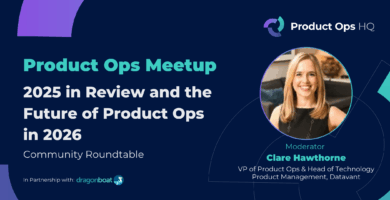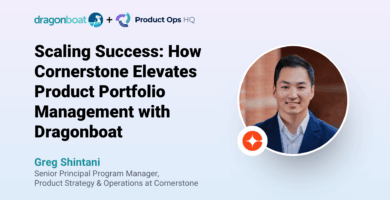Events • On Demand | Watch Time: 43 Min
Replace Your Roadmap With a Responsive Portfolio to Drive Outcomes
In the waterfall era, there was an annual planning process where business goals led to initiatives and corresponding budget allocation. In today’s fast-moving world, annual planning does not meet the needs. It’s too top-down, budget-oriented, and does not connect engineering resources (input) and product KPIs (output) in the process. It’s time to replace your roadmap with a responsive portfolio.
In the third part of this series, Becky will cover how to connect annual vision with quarterly goals and weekly check-ins to allow rapid product innovation while ensuring continued improvements of existing product experience and growth.
Some of the topics include:
- Defining and getting buy-in on product objectives / OKRs
- Negotiating and planning roadmap dependencies and resources
- Building outcome-focused roadmaps
“Create a portfolio that looks at the customer, product, and business outcome angle to think about how to best allocate your focus. In turn, your roadmap will serve as a snapshot of your product portfolio for that moment in time”Becky Flint on creating an outcome-driven roadmap
There are 3 components to keep in mind when you replace your roadmap with a responsive portfolio:
- Define and achieve buy-in on product objectives/OKRs
- Negotiate and plan roadmap dependencies and resources
- Build outcome-focused roadmaps
Defining product objectives: Account for both the new and existing market, before setting your allocation and sharing your goals with your teams. Make sure to break your bigger goals down into smaller goals before handing them over to your teams.
Negotiating roadmap dependencies: This step is the “get-it-done” part, and it comes once you align strategy and focus. However, don’t be fooled, this step may be easy to understand, but it is hard to execute. When approaching this step, first think about your business goals and strategy, allocate your resources, and then identify dependencies (visualize and track them with a dependable tool).
Building outcome-focused roadmaps: This step will help you avoid becoming a feature factory. There are a few practices you may need to unlearn. Most product managers are taught to maintain a groomed product backlog, but that in itself can lead to prioritizing the wrong things (i.e. only what’s asked for, and not what’s actually needed). Start by aligning and allocating before prioritizing.
“If you think about product management, it’s really about delivering values and outcomes to customers. Responsive product portfolio management is how you effectively run teams. It’s a continuous strategic product process. That is true agile”– Becky Flint on what true agile practices are
There are moments where we need to be head down, but also moments where we need to step back. Don’t only fill your portfolio with small features, make sure you think big. You only need a handful of big rocks to move the needle. If you have too many, nothing will ever get done.
“Remember that changes in the roadmap aren’t bad, they’re in service of the outcome.”– Rachel Weston Rowell on outcome-driven roadmapping
About the Speakers
Becky Flint built and scaled product portfolio management at PayPal, Bigcommerce, Shutterfly, and Feedzai. She is also the founder of Dragonboat, an integrated product portfolio platform that helps product teams strategize, prioritize, deliver, and improve industry-leading products.
Rachel Weston Rowell has over 15 years of experience in agile and product leadership. As SVP, Product & Technology COE at Insight Partners, Rachel focuses on high-level business strategy and organizational discipline so they can successfully scale while aligned.
You can watch the rest of the 3-part series.

Featured Speakers

Becky Flint
Founder and CEO of Dragonboat
Becky is a product and tech executive based in the Silicon Valley. She has built and scaled product and engineering teams globally for both startups and Fortune 500 companies. Currently Becky is the Founder and CEO of Dragonboat with a mission to empower responsive leaders and their teams to build better products faster. Prior to founding Dragonboat, Becky has held executive roles at Feedzai, Bigcommerce, Tinyprints/Shutterfly, and PayPal.

Rachel Weston Rowell
SVP, Product & Technology COE
Has over 15 years of experience in agile and product leadership. As SVP, Product & Technology COE at Insight Partners, Rachel focuses on high-level business strategy and organizational discipline so they can successfully scale while aligned.


